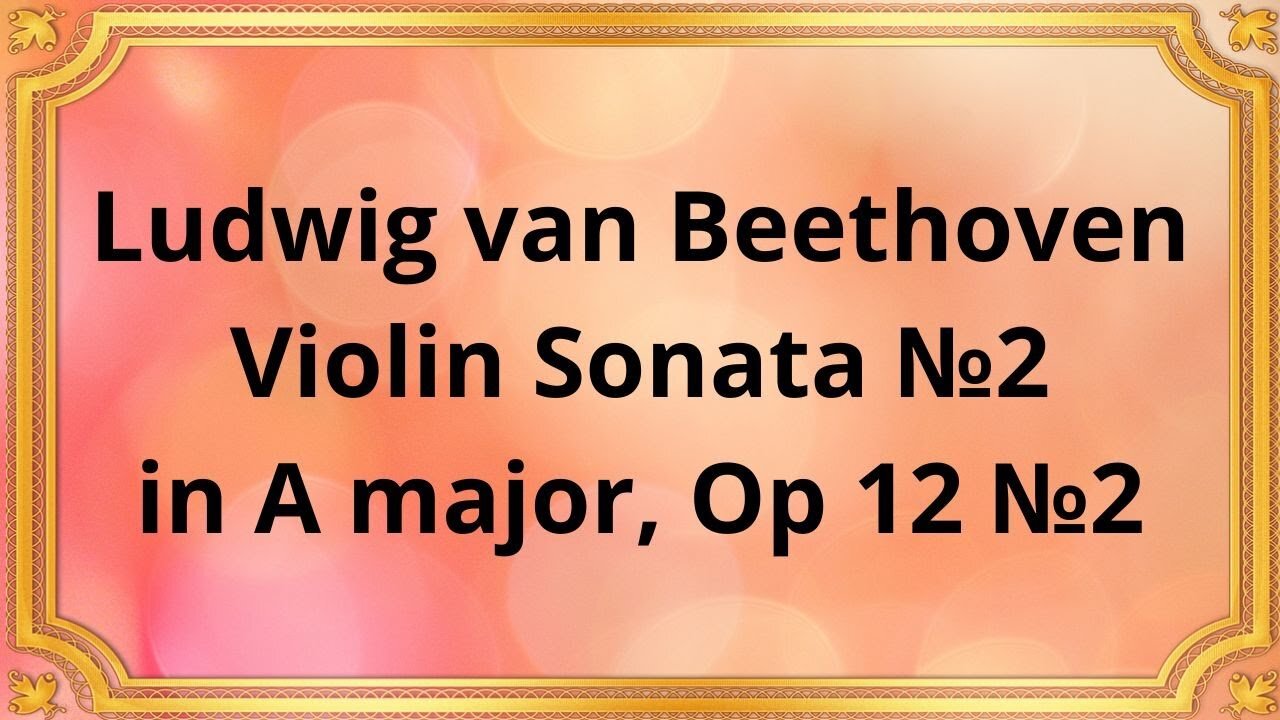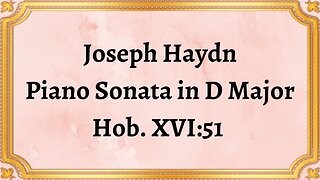Premium Only Content

Ludwig van Beethoven Violin Sonata №2 in A major, Op 12 №2
#Beethoven #ClassicalMusic #ViolinSonata #AMajor #Op12No2 #MusicAppreciation #SonataForm #MusicHistory #Composer #RomanticEra
Wolfgang Schneiderhan, Wilhelm Kempff
Ludwig van Beethoven, one of the most influential composers in history, left an indelible mark on classical music with his revolutionary compositions. Among his vast musical repertoire, the Violin Sonata No. 2 in A Major, Op 12 No. 2, stands as a shining example of his genius.
Beethoven composed the Violin Sonata No. 2 in A Major, Op 12 No. 2, during the late 18th century, a time of transition from the Classical era to the Romantic period. This sonata, written around 1798-1799, showcases Beethoven's departure from the traditional classical style and foreshadows the bold and expressive characteristics that would define his later works.
The Violin Sonata No. 2 follows the traditional three-movement structure commonly found in sonatas of the time. The first movement, marked Allegro vivace, introduces a lively and energetic theme that immediately captivates the listener. The second movement, marked Andante, provides a contrast with its lyrical and introspective character, creating a serene and reflective atmosphere. The final movement, marked Allegro piacevole, brings the sonata to a spirited and joyful conclusion, showcasing Beethoven's mastery of musical expression.
Beethoven's Violin Sonata No. 2 is notable for its innovative and expressive elements. The composition skillfully combines lyricism, virtuosity, and emotional depth, creating a captivating musical experience. Beethoven employs bold dynamic contrasts, sudden shifts in mood, and unexpected harmonic progressions, pushing the boundaries of traditional classical music. These expressive elements allow the performer and the listener to embark on a journey filled with passion, drama, and profound emotions.
The Violin Sonata No. 2 highlights the importance of the collaboration between the violin and piano. Beethoven grants both instruments equal importance, engaging them in a musical conversation throughout the piece. The violin and piano complement each other, intertwining their melodies, harmonies, and rhythms to create a harmonious and balanced musical dialogue.
Beethoven's Violin Sonata No. 2 in A Major, Op 12 No. 2, continues to captivate audiences and musicians alike with its timeless beauty and artistic depth. Its innovative and expressive qualities have made it an essential part of the violin and piano repertoire. This composition showcases Beethoven's remarkable ability to evoke a wide range of emotions, from tender lyricism to exhilarating virtuosity. The Violin Sonata No. 2 stands as a testament to Beethoven's enduring legacy and his profound impact on the evolution of classical music.
Conclusion:
Ludwig van Beethoven's Violin Sonata No. 2 in A Major, Op 12 No. 2, is a testament to the composer's artistic brilliance and his transformative impact on classical music. Its innovative structure, expressive elements, and collaborative nature make it a treasured gem of the violin and piano repertoire. This composition continues to inspire and move audiences, reminding us of Beethoven's unparalleled contributions to the world of music.
You have the opportunity to support the channel:
https://destream.net/live/RadSiarAl/donate
https://www.buymeacoffee.com/6355radsiaral
-
 6:07
6:07
Classical music_Music Inspiration
1 month agoJoseph Haydn Piano Sonata in D Major, Hob. XVI:51
921 -
 1:43:21
1:43:21
Redacted News
10 hours agoBREAKING! UKRAINE AGREES TO CEASEFIRE WITH RUSSIA... BUT THERE'S A BIG CATCH | Redacted News
186K318 -
 58:17
58:17
Candace Show Podcast
10 hours agoShould We Feel Bad For Blake Lively? | Candace Ep 157
158K299 -
 3:06:52
3:06:52
The Nerd Realm
11 hours ago $12.30 earnedHollow Knight Voidheart Edition #19 | Nerd Realm Playthrough
95K6 -
 1:17:27
1:17:27
Awaken With JP
13 hours agoThe Current Thing: Tesla Protesting - LIES Ep 82
163K76 -
 1:07:08
1:07:08
Sean Unpaved
10 hours agoNFL Free Agency Rolls On! MLB Spring Training Heats Up along with 3x World Series Champ Dave Stewart
97.6K3 -
 2:10:15
2:10:15
Right Side Broadcasting Network
15 hours agoLIVE REPLAY: White House Press Secretary Karoline Leavitt Holds Press Briefing - 3/11/25
182K45 -
 2:06:00
2:06:00
The Quartering
14 hours agoTrump Goes NUCLEAR On Canada, Blasts Massie, Harry Potter Race Swap, Man Humiliated On TV Show
131K69 -
 1:03:09
1:03:09
The White House
13 hours agoPress Secretary Karoline Leavitt Briefs Members of the Media, Mar. 11, 2025
124K75 -
 1:07:03
1:07:03
Winston Marshall
13 hours agoEXCLUSIVE : Oliver Anthony On Life After ‘Rich Men’, The Christian Counter Culture and The Elites
82.4K13